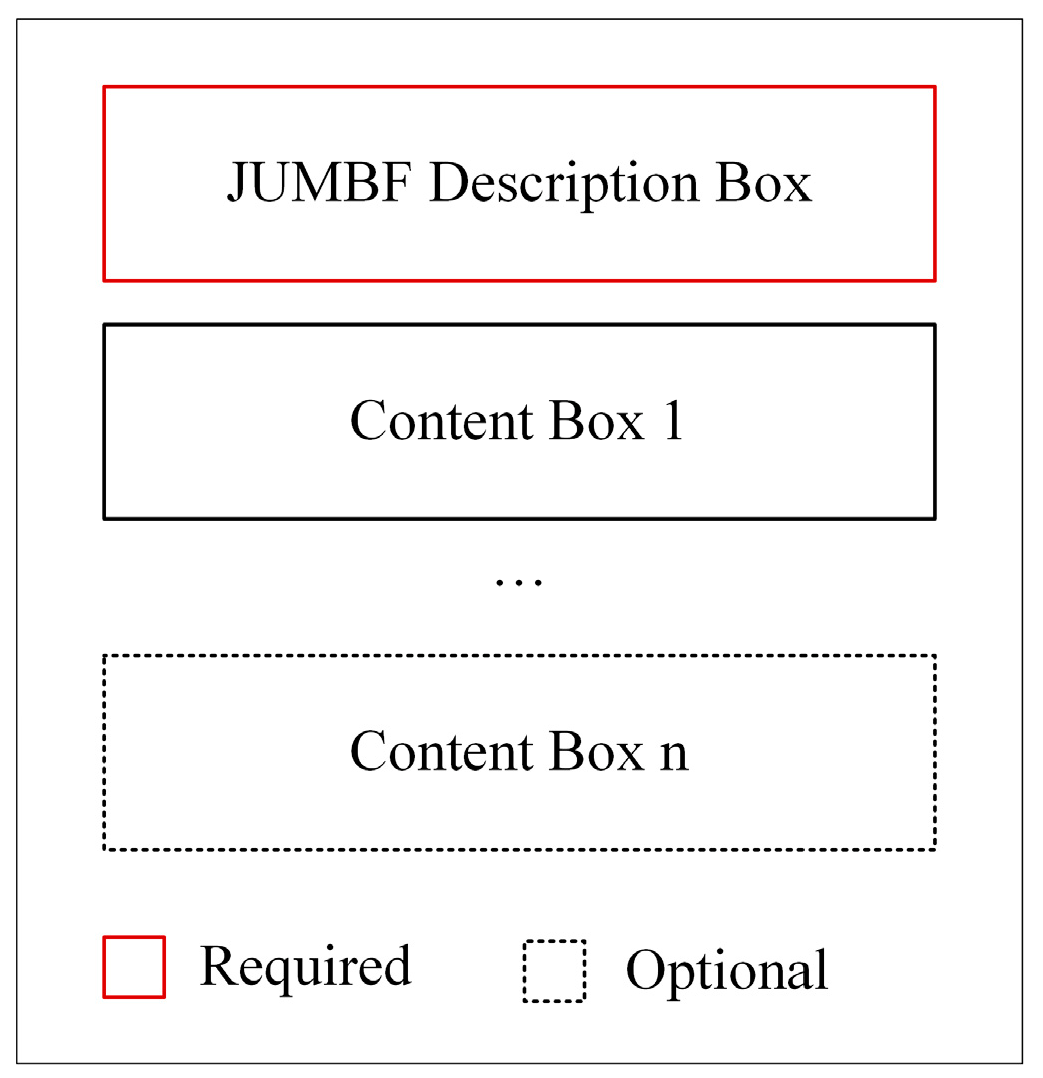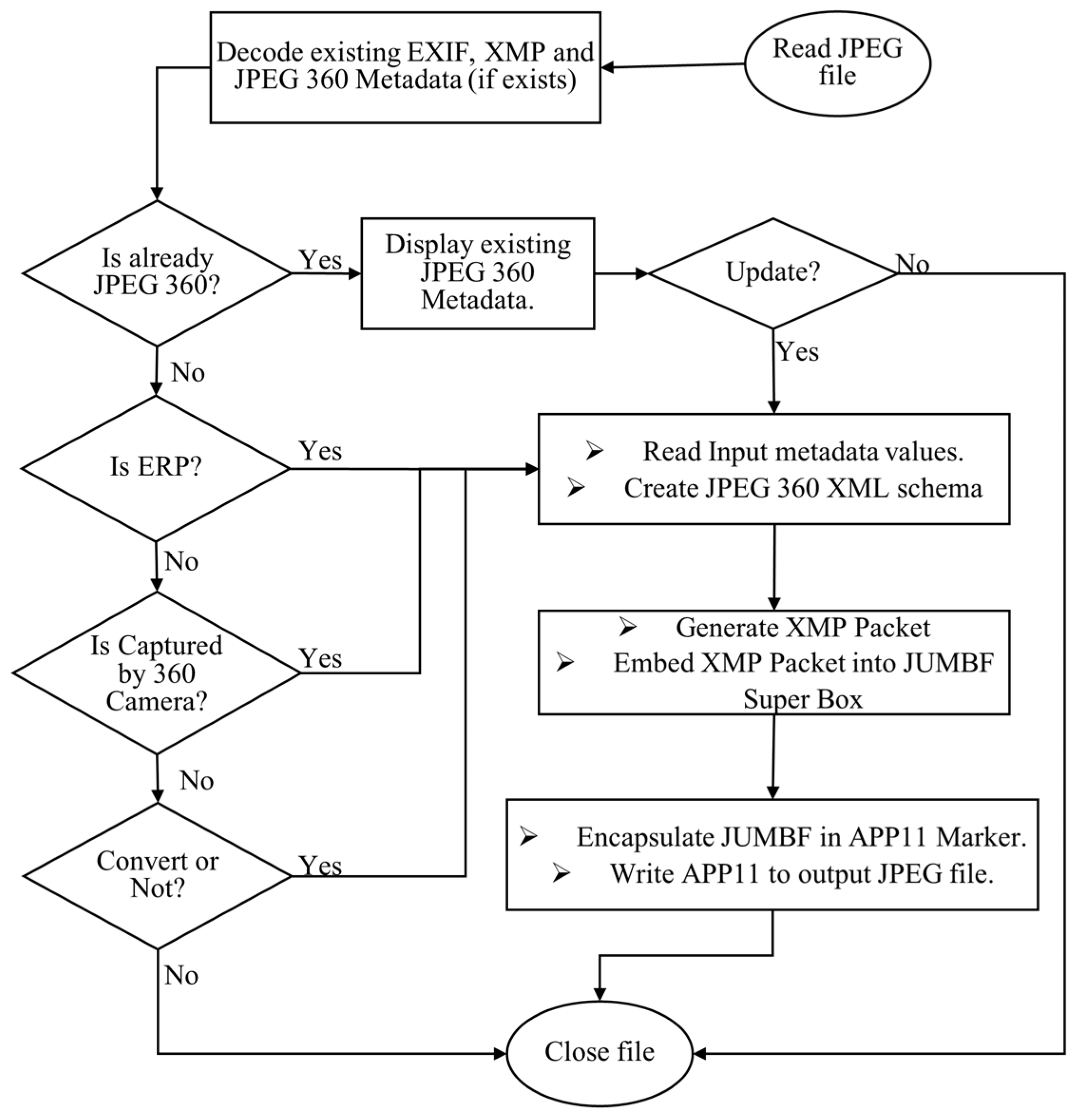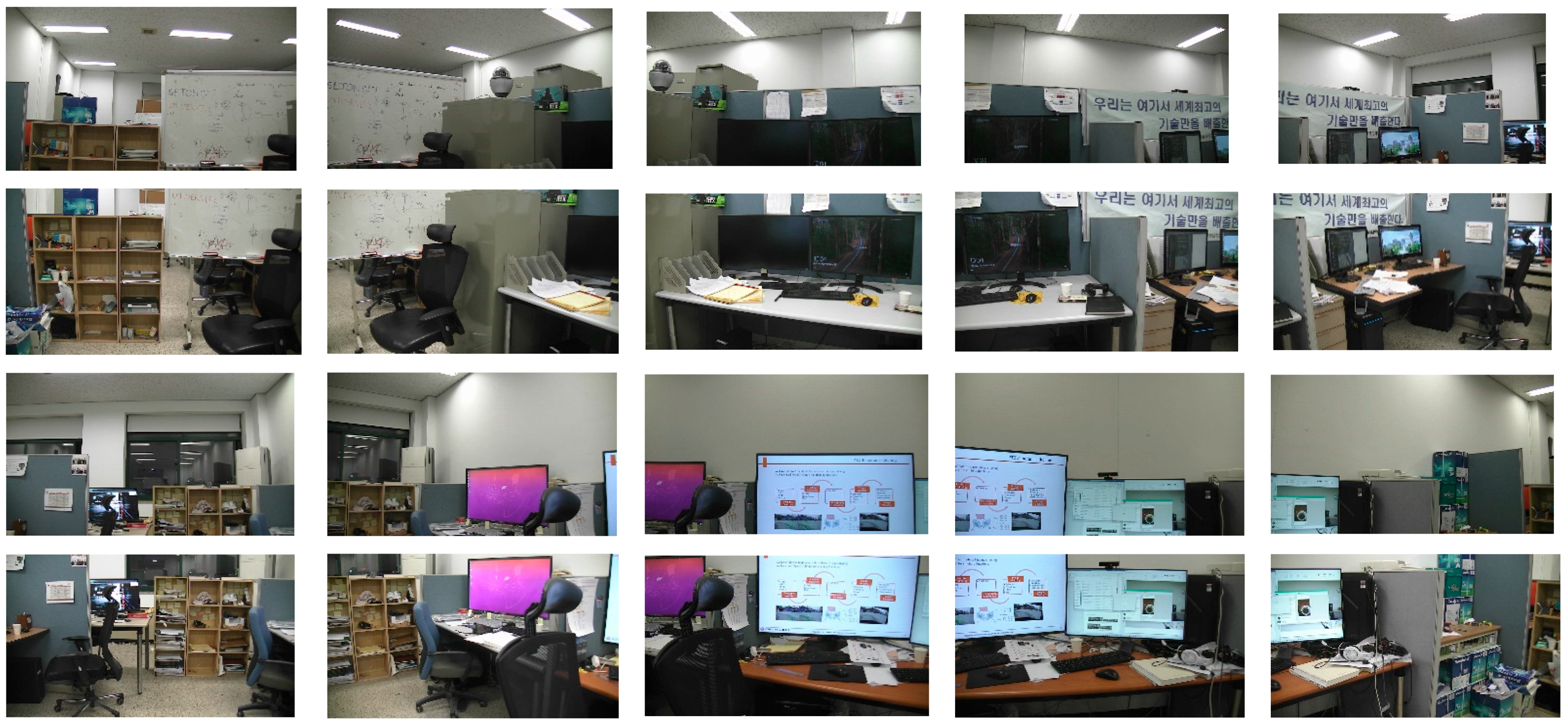Generation of a Panorama Compatible with the JPEG 360 International Standard Using a Single PTZ Camera
Abstract
:1. Introduction
2. Related Work
2.1. Literature Review
2.2. JPEG-1 Image Coding Standard
2.3. JPEG-1 Image File Structure
3. Proposed Converter and PTZ Panorama
3.1. Metadata Survey in 360-Degree Images
3.2. GPano Metadata Schema
3.3. JPEG 360
3.4. Comparison of JPEG 360 with GPano
3.5. JPEG-1 to JPEG 360 Converter
3.6. PTZ Panorama
4. Implementation and Results
4.1. JPEG 360 Converter
4.2. PTZ Panorama
4.3. Results
5. Discussion
6. Conclusions
Author Contributions
Funding
Institutional Review Board Statement
Informed Consent Statement
Conflicts of Interest
References
- Timmerer, C.; Graf, M.; Mueller, C. Adaptive Streaming of vr/360-Degree Immersive Media Services with High Qoe. In Proceedings of the 2017 NAB Broadcast Engineering and IT Conference (BEITC), Las Vegas, NV, USA, 22–27 April 2017. [Google Scholar]
- Yang, Y.; Jenny, B.; Dwyer, T.; Marriott, K.; Chen, H.; Cordeil, M. Maps and Globes in Virtual Reality. In Computer Graphics Forum; Wiley Online Library: New York, NY, USA, 2018; Volume 37, pp. 427–438. [Google Scholar]
- Eiris, R.; Gheisari, M.; Esmaeili, B. PARS: Using augmented 360-degree panoramas of reality for construction safety training. Int. J. Environ. Res. Public Health 2018, 15, 2452. [Google Scholar] [CrossRef] [PubMed] [Green Version]
- Adachi, R.; Cramer, E.M.; Song, H. Using virtual reality for tourism marketing: A mediating role of self-presence. Soc. Sci. J. 2020, 12, 1–14. [Google Scholar] [CrossRef]
- Reyna, J. The Potential of 360-Degree Videos for Teaching, Learning and Research. In Proceedings of the INTED2018 Conference, Valencia, Spain, 5–7 March 2018; pp. 1448–1454. [Google Scholar]
- Eiris, R.; Gheisari, M.; Esmaeili, B. Desktop-based safety training using 360-degree panorama and static virtual reality techniques: A comparative experimental study. Autom. Constr. 2020, 109, 102969. [Google Scholar] [CrossRef]
- Hudson, G.; Léger, A.; Niss, B.; Sebestyén, I. JPEG at 25: Still going strong. IEEE MultiMedia 2017, 24, 96–103. [Google Scholar] [CrossRef]
- Pennebaker, W.B.; Mitchell, J.L. JPEG: Still Image Data Compression Standard; Springer Science & Business Media: Berlin/Heidelberg, Germany, 1992. [Google Scholar]
- Ellen, J.S.; Graff, C.A.; Ohman, M.D. Improving plankton image classification using context metadata. Limnol. Oceanogr. Methods 2019, 17, 439–461. [Google Scholar] [CrossRef] [Green Version]
- Riggs, C.; Douglas, T.; Gagneja, K. Image Mapping through Metadata. In Proceedings of the 2018 Third International Conference on Security of Smart Cities, Industrial Control System and Communications (SSIC), Shanghai, China, 18–19 October 2018; pp. 1–8. [Google Scholar]
- Temmermans, F.; Kuzma, A.; Choi, S.; Park, J.-H.; Schelkens, P. Adopting the JPEG systems layer to create interoperable imaging ecosystems (Conference Presentation). In Proceedings of the Optics, Photonics and Digital Technologies for Imaging Applications VI, online in Europe, 17 April 2020; p. 113530T. [Google Scholar]
- Information Technologies—JPEG Systems—Part 5: JPEG Universal Metadata Box Format (JUMBF), ISO/IEC 19566-5. 2019. Available online: https://www.iso.org/standard/73604.html (accessed on 21 November 2021).
- Information Technologies—JPEG Systems—Part 6: JPEG 360, ISO/IEC 19566-6. 2019. Available online: https://www.iso.org/standard/75846.html (accessed on 21 November 2021).
- Richter, T.; Artusi, A.; Ebrahimi, T. JPEG XT: A new family of JPEG backward-compatible standards. IEEE Multimed. 2016, 23, 80–88. [Google Scholar] [CrossRef]
- Falk, M.T.; Hagsten, E. When international academic conferences go virtual. Scientometrics 2021, 126, 707–724. [Google Scholar] [CrossRef] [PubMed]
- Price, M. Scientists discover upsides of virtual meetings. Science 2020, 368, 457–458. [Google Scholar] [CrossRef]
- Rubinger, L.; Gazendam, A.; Ekhtiari, S.; Nucci, N.; Payne, A.; Johal, H.; Khanduja, V.; Bhandari, M. Maximizing virtual meetings and conferences: A review of best practices. Int. Orthop. 2020, 44, 1461–1466. [Google Scholar] [CrossRef]
- Duan, Y.; Han, C.; Tao, X.; Geng, B.; Du, Y.; Lu, J. Panoramic Image Generation: From 2-D Sketch to Spherical Image. IEEE J. Sel. Top. Signal Process. 2020, 14, 194–208. [Google Scholar] [CrossRef]
- Bertel, T.; Yuan, M.; Lindroos, R.; Richardt, C. OmniPhotos: Casual 360° VR Photography. ACM Trans. Graph. 2020, 39, 1–12. [Google Scholar] [CrossRef]
- Akimoto, N.; Kasai, S.; Hayashi, M.; Aoki, Y. 360-Degree Image Completion by Two-Stage Conditional Gans. In Proceedings of the 2019 IEEE International Conference on Image Processing (ICIP), Taipei, Taiwan, 22–25 September 2019; pp. 4704–4708. [Google Scholar]
- Ullah, H.; Zia, O.; Kim, J.H.; Han, K.; Lee, J.W. Automatic 360° Mono-Stereo Panorama Generation Using a Cost-Effective Multi-Camera System. Sensors 2020, 20, 3097. [Google Scholar] [CrossRef]
- Berenguel-Baeta, B.; Bermudez-Cameo, J.; Guerrero, J.J. OmniSCV: An Omnidirectional Synthetic Image Generator for Computer Vision. Sensors 2020, 20, 2066. [Google Scholar] [CrossRef] [Green Version]
- Duanmu, F.; Mao, Y.; Liu, S.; Srinivasan, S.; Wang, Y. A subjective study of viewer navigation behaviors when watching 360-degree videos on computers. In Proceedings of the 2018 IEEE International Conference on Multimedia and Expo (ICME), San Diego, CA, USA, 23–27 July 2018; pp. 1–6. [Google Scholar]
- Zhang, Y.; Zhang, H.; Li, D.; Liu, L.; Yi, H.; Wang, W.; Suitoh, H.; Odamaki, M. Toward Real-World Panoramic Image Enhancement. In Proceedings of the IEEE/CVF Conference on Computer Vision and Pattern Recognition Workshops, Virtual, 14–19 June 2020; pp. 628–629. [Google Scholar]
- Zhu, Y.; Zhai, G.; Min, X.; Zhou, J. The prediction of saliency map for head and eye movements in 360 degree images. IEEE Trans. Multimed. 2019, 22, 2331–2344. [Google Scholar] [CrossRef]
- Adhuran, J.; Kulupana, G.; Galkandage, C.; Fernando, A. Multiple Quantization Parameter Optimization in Versatile Video Coding for 360° Videos. IEEE Trans. Consum. Electron. 2020, 66, 213–222. [Google Scholar] [CrossRef]
- Kim, H.G.; Lim, H.-T.; Ro, Y.M. Deep virtual reality image quality assessment with human perception guider for omnidirectional image. IEEE Trans. Circ. Syst. Video Technol. 2019, 30, 917–928. [Google Scholar] [CrossRef]
- Orduna, M.; Díaz, C.; Muñoz, L.; Pérez, P.; Benito, I.; García, N. Video multimethod assessment fusion (vmaf) on 360vr contents. IEEE Trans. Consum. Electron. 2019, 66, 22–31. [Google Scholar] [CrossRef] [Green Version]
- Information Technology—Digital Compression and Coding of Continuous-Tone Still Images: Requirements and Guidelines, ISO/IEC 10918-1. 1994. Available online: https://www.iso.org/standard/18902.html (accessed on 21 November 2021).
- Information Technology—Digital Compression and Coding of Continuous-Tone Still Images: JPEG File Interchange Format (JFIF)—Part 5, ISO/IEC 10918-5. 2013. Available online: https://www.iso.org/standard/54989.html (accessed on 21 November 2021).
- Exchangeable Image File Format for Digital Still Cameras: Exif Version 2.2 JEITA CP-3451. 2002. Available online: https://www.exif.org/Exif2-2.PDF (accessed on 21 November 2021).
- TIFF 6.0 Specification. 1992. Available online: https://www.itu.int/itudoc/itu-t/com16/tiff-fx/docs/tiff6.pdf (accessed on 21 November 2021).
- Graphic Technology—Extensible Metadata Platform (XMP)—Part 1: Data Model, Serialization and Core Properties. ISO 16684-1/2019. Available online: https://www.iso.org/standard/75163.html (accessed on 21 November 2021).
- Information Technology—Scalable Compression and Coding of Continuous-Tone Still Images—Part 3: Box File Format, ISO/IEC 18477-3. 2015. Available online: https://www.iso.org/standard/66071.html (accessed on 21 November 2021).
- Photo Sphere XMP Metadata. Google. Available online: https://developers.google.com/streetview/spherical-metadata (accessed on 13 September 2021).
- OpenCV. Available online: https://sourceforge.net/projects/opencvlibrary/files/4.4.0/opencv-4.4.0-vc14_vc15.exe/download (accessed on 13 September 2021).
- Bay, H.; Tuytelaars, T.; Van Gool, L. Surf: Speeded up robust features. In European Conference on Computer Vision; Springer: Berlin/Heidelberg, Germany, 2006; pp. 404–417. [Google Scholar]
- Lowe, D.G. Distinctive image features from scale-invariant keypoints. Int. J. Comput. Vis. 2004, 60, 91–110. [Google Scholar] [CrossRef]
- Leutenegger, S.; Chli, M.; Siegwart, R.Y. BRISK: Binary robust invariant scalable keypoints. In Proceedings of the 2011 International Conference on Computer Vision, Barcelona, Spain, 6–13 November 2011; pp. 2548–2555. [Google Scholar]
- Alcantarilla, P.F.; Solutions, T. Fast explicit diffusion for accelerated features in nonlinear scale spaces. IEEE Trans. Patt. Anal. Mach. Intell 2011, 34, 1281–1298. [Google Scholar]
- Ha, Y.-J.; Kang, H.-D. Evaluation of feature based image stitching algorithm using OpenCV. In Proceedings of the 2017 10th International Conference on Human System Interactions (HSI), Ulsan, Korea, 17–19 July 2017; pp. 224–229. [Google Scholar]
- Derpanis, K.G. Overview of the RANSAC Algorithm. Image Rochester NY 2010, 4, 2–3. [Google Scholar]
- Burt, P.J.; Adelson, E.H. A multiresolution spline with application to image mosaics. ACM Trans. Graph. TOG 1983, 2, 217–236. [Google Scholar] [CrossRef]














| ISO Project No | Title | Status | Publication Date |
|---|---|---|---|
| 19566-1:2016 | JPEG Systems—Part 1: Packaging of information using codestream and file formats | Technical report (TR) | 2016-03 |
| 19566-2:2016 | JPEG Systems—Part 2: Transport mechanisms and packaging | TR | 2016-10 |
| 19566-3 | JPEG Systems—Part 3: Feature list and box type IDs | Canceled | |
| 19566-4:2020 | JPEG Systems—Part 4: Privacy and security | International Standard (IS) | 2020-03 |
| 19566-5:2019 | JPEG Systems—Part 5: JPEG universal metadata box format (JUMBF) | IS | 2019-07 |
| 19566-5:2019/AMD1 | JPEG Systems—Part 5: JPEG universal metadata box format (JUMBF)—Amendment 1: Support for embedding mixed code streams | IS | 2021-06 |
| 19566-6:2019 | JPEG Systems—Part 6: JPEG 360 | IS | 2019-07 |
| 19566-6:2019/AMD1 | JPEG Systems—Part 6: JPEG 360—Amendment 1: Addition of new JPEG 360 image types and accelerated ROI rendering | IS | 2021-06 |
| 19566-7 | JPEG Systems—Part 7: JPEG linked media format (JLINK) | Final Draft IS | IS expected on 2022-04 |
| 19566-8 | JPEG Systems—Part 8: JPEG Snack | Draft IS | IS expected on 2022-10 |
| Short Name | ID Bytes | Name and Comments |
|---|---|---|
| SOI | 0xFFD8 | Start of the image |
| SOF0 | 0xFFC0 | Start of the Frame Baseline DCT. Width, height, the number of the components, and component’s subsampling are specified in this segment |
| SOF2 | 0xFFC2 | Start of the Frame Progressive DCT. Width, height, the number of the components, and component’s subsampling are specified in this segment |
| DHT | 0xFFC4 | Define Huffman Table(s) |
| DQT | 0xFFDB | Define Quantization Table(s) |
| DRI | 0xFFDD | Define Restart Interval. Specifies the interval between RSTn markers |
| SOS | 0xFFDA | Start of the scan. Top to bottom scan of the image |
| RSTn | 0xFFDn (n = 0–7) | Restart |
| APPn | 0xFFEn | Application-specific. Like EXIF/JFIF |
| COM | 0xFFFE | Comment |
| EOI | 0xFFD9 | End of the image |
| No | Box UUID | Box Name | Content Type Box ID | Box ID in Hex |
|---|---|---|---|---|
| 1 | 0x6579D6FB-DBA2-446B-B2AC-1B82FEEB89D1 | Codestream content-type box | ‘jp2c’ | 0x6A703263 |
| 2 | 0x786D6C20-0011-0010-8000-00AA00389B71 | XML content-type box | ‘xml\040′ | 0x786D6C20 |
| 3 | 0x6A736F6E-0011-0010-8000-00AA00389B71 | JSON content-type box | ‘json’ | 0x6A736F6E |
| 4 | 0x75756964-0011-0010-8000-00AA00389B71 | UUID box | ‘uuid’ | 0x75756964 |
| 5 | 0x785F34B7-5D4B-474C-B89F-1D99E0E3A8DD | JPEG 360 XML metadata box | ‘xml\040′ | 0x786D6C20 |
| No | Property Name | Type | Default |
|---|---|---|---|
| 1 | UsePanoramaViewer | Boolean | True |
| 2 | CaptureSoftware | String | n/a |
| 3 | StitchingSoftware | String | n/a |
| 4 | ProjectionType | String | Equirectangular |
| 5 | PoseHeadingDegrees | Real | 0 |
| 6 | PosePitchDegrees | Real | 0 |
| 7 | PoseRollDegrees | Real | 0 |
| 8 | InitialViewHeadingDegrees | Integer | 0 |
| 9 | InitialViewPitchDegrees | Integer | 0 |
| 10 | InitialViewRollDegrees | Integer | 0 |
| 11 | InitialHorizontalFOVdegrees | Real | n/a |
| 12 | InitialVerticalFOVDegrees | Real | n/a |
| 13 | FirstPhotoDate | Date | n/a |
| 14 | LastPhotoDate | Date | n/a |
| 15 | SourcePhotoCount | Integer | n/a |
| 16 | ExposureLockUsed | Boolean | n/a |
| 17 | CroppedAreaImageWidthPixels | Integer | n/a |
| 18 | CroppedAreaImageHeightPixels | Integer | n/a |
| 19 | FullPanoWidthPixels | Integer | n/a |
| 20 | FullPanoHeightPixels | Integer | n/a |
| 21 | CroppedAreaLeftPixels | Integer | n/a |
| 22 | CroppedAreaTopPixels | Integer | n/a |
| 23 | InitialCameraDolly | Real | 0 |
| No | Property Name | Type | Default |
|---|---|---|---|
| A | JPEG360ImageMetadata | ||
| 1 | JPEG360Version | Integer | 1 |
| 2 | MediaType | String | Image/jpeg |
| 3 | ProjectionType | String | Equirectangular |
| 4 | PhiMin | Real | −180 |
| 5 | PhiMax | Real | +180 |
| 6 | ThetaMin | Real | −90 |
| 7 | ThetaMax | Real | +90 |
| 8 | PhiGravity | Real | 0 |
| 9 | ThetaGravity | Real | −90 |
| 10 | CompassPhi | Real | 0 |
| 11 | BoxReference | String | Conventional |
| B | JPEG360ViewportMetadata | ||
| 1 | JPEG360ViewportNumber | Integer | 0 |
| 2 | ViewportPhi | Real | 0 |
| 3 | ViewportTheta | Real | 0 |
| 4 | ViewportPhiFOV | Real | 100 |
| 5 | ViewportThetaFOV | Real | 75 |
| 6 | ViewportRoll | Real | 0 |
| No | Property Supported | GPano | JPEG 360 |
|---|---|---|---|
| 1 | Full ERP projection | Yes | Yes |
| 2 | Partial ERP projection | Yes | Yes |
| 3 | Cylindrical projection | Yes | No |
| 4 | Image codestream in different box (box reference) | No | Yes |
| 5 | Gravity | No | Yes |
| 6 | Compass | Yes | Yes |
| 7 | Multiple viewports | No | Yes |
| 8 | Viewport width and height | No | Yes |
| 9 | Viewport center | Yes | Yes |
| 10 | Viewport roll | No | Yes |
| No | Property Name | Camera in Center | Camera on Side | Camera in Corner |
|---|---|---|---|---|
| A | JPEG360ImageMetadata | |||
| 1 | JPEG360Version | 1 | 1 | 1 |
| 2 | MediaType | Image/JPEG | Image/JPEG | Image/JPEG |
| 3 | ProjectionType | Spherical | Spherical | Spherical |
| Cylindrical | Cylindrical | Cylindrical | ||
| 4 | PhiMin | −180 | −90 | −45 |
| 5 | PhiMax | +180 | +90 | +45 |
| 6 | ThetaMin | −18 (rows = 1) | −18 (rows = 1) | −18 (rows = 1) |
| −28 (rows = 2) | −28 (rows = 2) | −28 (rows = 2) | ||
| 7 | ThetaMax | +18 (rows = 1) | +18 (rows = 1) | +18 (rows = 1) |
| +28 (rows = 2) | +28 (rows = 2) | +28 (rows = 2) | ||
| 8 | PhiGravity | 0 | 0 | 0 |
| 9 | ThetaGravity | −90 | −90 | −90 |
| 10 | CompassPhi | 0 | 0 | 0 |
| 11 | BoxReference | Conventional | Conventional | Conventional |
| B | JPEG360ViewportMetadata | |||
| 1 | JPEG360ViewportNumber | 0 | 0 | 0 |
| 2 | ViewportPhi | 0 | 0 | 0 |
| 3 | ViewportTheta | 0 | 0 | 0 |
| 4 | ViewportPhiFOV | 48 (rows = 1) | 48 (rows = 1) | 48 (rows = 1) |
| 74 (rows = 2) | 74 (rows = 2) | 74 (rows = 2) | ||
| 5 | ViewportThetaFOV | 36 (rows = 1) | 36 (rows = 1) | 36 (rows = 1) |
| 56 (rows = 2) | 56 (rows = 2) | 56 (rows = 2) | ||
| 6 | ViewportRoll | 0 | 0 | 0 |
| Features Algo | Position | Center | Side | Corner | |||
|---|---|---|---|---|---|---|---|
| Config Projection | 2 Rows | 1 Row | 2 Rows | 1 Row | 2 Rows | 1 Row | |
| SURF | Spherical | 17.862 | 12.258 | 2.992 | 1.048 | 1.978 | 0.529 |
| Cylindrical | 19.963 | 13.032 | 2.946 | 0.901 | 2.946 | 0.525 | |
| SIFT | Spherical | 12.356 | 2.729 | 3.428 | 1.129 | 1.765 | 0.725 |
| Cylindrical | 12.865 | 2.824 | 3.386 | 1.16 | 1.82 | 0.682 | |
| ORB | Spherical | 8.824 | 2.199 | 2.522 | 0.793 | 1.157 | 0.395 |
| Cylindrical | 8.046 | 2.623 | 2.28 | 0.599 | 1.195 | 0.400 | |
| AKAZE | Spherical | 8.918 | 2.359 | 3.045 | 1.008 | 1.462 | 0.574 |
| Cylindrical | 8.82 | 2.236 | 2.936 | 0.975 | 1.833 | 0.581 | |
Publisher’s Note: MDPI stays neutral with regard to jurisdictional claims in published maps and institutional affiliations. |
© 2021 by the authors. Licensee MDPI, Basel, Switzerland. This article is an open access article distributed under the terms and conditions of the Creative Commons Attribution (CC BY) license (https://creativecommons.org/licenses/by/4.0/).
Share and Cite
Ullah, F.; Kwon, O.-J.; Choi, S. Generation of a Panorama Compatible with the JPEG 360 International Standard Using a Single PTZ Camera. Appl. Sci. 2021, 11, 11019. https://doi.org/10.3390/app112211019
Ullah F, Kwon O-J, Choi S. Generation of a Panorama Compatible with the JPEG 360 International Standard Using a Single PTZ Camera. Applied Sciences. 2021; 11(22):11019. https://doi.org/10.3390/app112211019
Chicago/Turabian StyleUllah, Faiz, Oh-Jin Kwon, and Seungcheol Choi. 2021. "Generation of a Panorama Compatible with the JPEG 360 International Standard Using a Single PTZ Camera" Applied Sciences 11, no. 22: 11019. https://doi.org/10.3390/app112211019
APA StyleUllah, F., Kwon, O.-J., & Choi, S. (2021). Generation of a Panorama Compatible with the JPEG 360 International Standard Using a Single PTZ Camera. Applied Sciences, 11(22), 11019. https://doi.org/10.3390/app112211019






